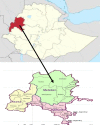Determinants of childhood diarrhea among underfive children in Benishangul Gumuz Regional State, North West Ethiopia
- PMID: 24731601
- PMCID: PMC4021233
- DOI: 10.1186/1471-2431-14-102
Determinants of childhood diarrhea among underfive children in Benishangul Gumuz Regional State, North West Ethiopia
Abstract
Background: Diarrhea is second only to pneumonia as the cause of child mortality worldwide. Developing countries particularly in Sub Saharan Africa including Ethiopia have a high burden of this disease. Studies showed that different factors were associated with the occurrence of childhood diarrhea. Therefore, this study was aimed to identify determinant factors of diarrhea in underfive children in Benishangul Gumuz Regional State, western Ethiopia.
Method: Demographic and Health Survey (DHS) data of 2011 was used for this study. The data was extracted from the National DHS data using data extraction tools. A total of 925 under five children were selected. The logistic regression model was employed to examine the determinants of childhood diarrhoea. Both bivariate and multivariate data analysis was performed using SPSS version 16.0.
Result: The results of this study indicated that low level of maternal education [AOR = 1.81, 95% CI (1.12,2.76)], absence of toilet facility [AOR = 3.5, 95% CI (2.4, 5.2)], improper child stool disposal methods [AOR = 2.05, 95%CI (1.36, 3.10)], having more than two under five children [AOR = 1.73, 95% CI (1.03, 2.93)], higher birth order [AOR = 6.1, 95% CI (3.1,12.2)] and the age of children [AOR = 1.9, 95% CI (1.2, 3.6)] were found to be the risk factors for childhood diarrhea after adjusting for other variables. When toilet facility was stratified by maternal education, it showed that children of mothers who had no education were the most vulnerable in the absence of toilet facilities [OR = 9.16, 95% CI (5.79, 14.48)].
Conclusion: Under poor environmental conditions, mothers with primary education and above protected their children against diarrhea better than mothers with no education. Thus, implementing effective educational programs that emphasize environmental health and sanitation practices and encouraging female school enrolment would reduce childhood diarrheal morbidity in the region.
Figures
Similar articles
-
Determinants of childhood diarrhea in Medebay Zana District, Northwest Tigray, Ethiopia: a community based unmatched case-control study.BMC Pediatr. 2018 Mar 29;18(1):120. doi: 10.1186/s12887-018-1098-7. BMC Pediatr. 2018. PMID: 29598815 Free PMC article.
-
Childhood diarrheal morbidity and sanitation predictors in a nomadic community.Ital J Pediatr. 2017 Oct 6;43(1):91. doi: 10.1186/s13052-017-0412-6. Ital J Pediatr. 2017. PMID: 28985750 Free PMC article.
-
Environmental factors affecting childhood diarrheal disease among under-five children in Jamma district, South Wello zone, Northeast Ethiopia.BMC Infect Dis. 2019 Sep 13;19(1):804. doi: 10.1186/s12879-019-4445-x. BMC Infect Dis. 2019. PMID: 31519160 Free PMC article.
-
Prevalence and risk factors of diarrhea among under-five children in Ethiopia: A systematic review and meta-analysis.BMC Public Health. 2025 May 16;25(1):1815. doi: 10.1186/s12889-025-22939-2. BMC Public Health. 2025. PMID: 40380143 Free PMC article.
-
Prevalence and determinants of diarrhea among under-five children in Ethiopia: A systematic review and meta-analysis.PLoS One. 2018 Jun 28;13(6):e0199684. doi: 10.1371/journal.pone.0199684. eCollection 2018. PLoS One. 2018. PMID: 29953555 Free PMC article.
Cited by
-
Geographical disparities and determinants of childhood diarrheal illness in Ethiopia: further analysis of 2016 Ethiopian Demographic and Health Survey.Trop Med Health. 2020 Aug 3;48:64. doi: 10.1186/s41182-020-00252-5. eCollection 2020. Trop Med Health. 2020. PMID: 32774127 Free PMC article.
-
Association between Maternal High-Risk Fertility Behavior and Childhood Morbidity in Bangladesh: A Nationally Representative Cross-Sectional Survey.Am J Trop Med Hyg. 2019 Oct;101(4):929-936. doi: 10.4269/ajtmh.19-0221. Am J Trop Med Hyg. 2019. PMID: 31333165 Free PMC article.
-
Household Microenvironment and Under-Fives Health Outcomes in Uganda: Focusing on Multidimensional Energy Poverty and Women Empowerment Indices.Int J Environ Res Public Health. 2022 May 30;19(11):6684. doi: 10.3390/ijerph19116684. Int J Environ Res Public Health. 2022. PMID: 35682268 Free PMC article.
-
Prevalence of oral rehydration therapy use and associated factors among under-five children with diarrhea in Dangure, Benishangul Gumuz Region, Ethiopia/2018.BMC Res Notes. 2019 Jan 30;12(1):67. doi: 10.1186/s13104-019-4078-6. BMC Res Notes. 2019. PMID: 30700333 Free PMC article.
-
Diarrheal disease in under-five children among model and non-model families in northern Ethiopia, 2017: a comparative cross-sectional study.BMC Res Notes. 2019 May 28;12(1):300. doi: 10.1186/s13104-019-4322-0. BMC Res Notes. 2019. PMID: 31138287 Free PMC article.
References
-
- UNICEF/WHO. Diarrhea: Why Children are Still Dying and What can be Done. New York: UNICEF; 2009. - PubMed
-
- Mekasha A, Tesfahun A. Determinants of diarrheal diseases: a community based study in urban South Western Ethiopia. East Afr Mediacal J. 2003;80(2):77–82. - PubMed
-
- Deribew A, Tessema F, Girma B. Determinants of under five mortality in Gilgel Gibie Field research center South west Ethiopia, Ethiop. J Health Dev. 2007;21(22):117–124.
-
- MOFED. Ethiopia: 2010 MDGs report: trends and Prospects in meeting MDGs in 2015. Addis Ababa: Federal Ministry of Finance and Economic Development; 2010.
Publication types
MeSH terms
Substances
LinkOut - more resources
Full Text Sources
Other Literature Sources
Medical


